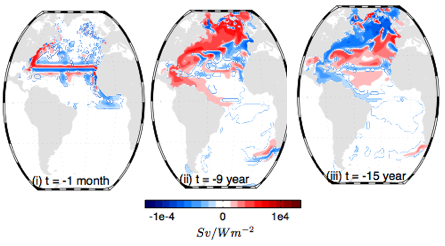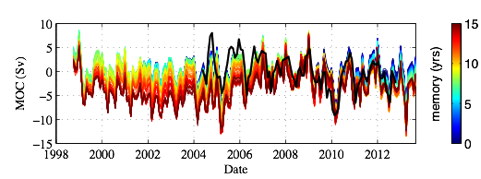by David Marshall
Fundamental questions we would like to answer in OSNAP are how changes in wind, thermal and freshwater forcing over the subpolar Atlantic modify the Atlantic Meridional Overturning Circulation (AMOC) at lower latitudes and on what time scales? These teleconnections are hard to unravel due to the complexities of the three-dimensional ocean circulation.
A conventional approach to addressing such questions to take a state-of-the-art ocean circulation model and modify the surface forcing in a large number different locations at different times in the past. The problem with this approach is that there are literally thousands of wind, thermal and freshwater forcing anomalies that we need to consider, each requiring a separate model integration.
An alternative approach, which we have used to interpret the AMOC time series at 26.5oN from the RAPID-MOCHA array, is to use an adjoint model (Pillar et al., 2015). The basic idea of an adjoint model is both simple and surprisingly subtle. Rather than run the model forwards in time, we run it backwards. In a conventional forward model, you perturb the initial conditions, for example, the wind forcing at some time in the past, and see how the three-dimensional circulation evolves differently at all times in the future. In an adjoint model, we purturb a single output, for example the AMOC at 26.5oN, and by run the model backwards to see how that output is sensitive to all forcing anomalies in the past.
The RAPID-MOCHA array has been monitoring the strength of the AMOC at 26.5oN continuously since 2004 (McCarthy et al., 2012). We have recently applied this adjoint modelling technique to investigate how much of the RAPID-MOCHA time series can be explained by projecting observed patterns of wind, thermal and freshwater forcing over the past 15 years onto the computed “adjoint sensitivities” and summing to infer their combined effect.

http://buyativan.org
earlier (Sv/Wm-2 per 1o model grid point). Red indicates that a positive ocean to atmosphere heat flux increases the AMOC. Thus heat loss over the subpolar gyre strengthens the AMOC 9 years later, but weakens the AMOC 15 years later (Pillar et al., 2015).” width=”294″ height=”163″ /> Figure 1: Sensitivity of the AMOC at 25oN to surface heat flux applied (i) 1 month, (ii) 9 years and (iii) 15 years earlier (Sv/Wm-2 per 1o model grid point). Red indicates that a positive ocean to atmosphere heat flux increases the AMOC. Thus heat loss over the subpolar gyre strengthens the AMOC 9 years later, but weakens the AMOC 15 years later (Pillar et al., 2015).In Figure 1, we show an example of adjoint sensitivities of the AMOC at 25oN in our model to surfaceheat fluxes, applied respectively at 1 month, 9 years and 15 years in the past. We find the largest buy acyclovir online sensitivities occur over the subpolar gyre at lags of around a decade, although curiously the sensitivities have opposite signs lags of 9 and 15 years. Thus subpolar heat loss to the atmosphere strengths the AMOC 9 years later, but weakens the AMOC 15 years later. We discussed this oscillatory sensitivity of the AMOC to subpolar buoyancy forcing in a recent paper (Czeschel et al., 2010).
In Figure 2, we show the impact on the AMOC at 25oN of cumulatively accounting for the history of wind, thermal and freshwater forcing over the past 1 to 15 years. Also shown in black is the RAPID-MOCHA AMOC time series at 26.5oN. At short time scales, the adjoint calculation is remarkably successful at reconstructing the observed AMOC variability, the vast majority of this signal coming from wind forcing.

Figure 2: Reconstruction of the AMOC at 25N by projecting the time history of observed wind, thermal and freshwater forcings over the past 15 years onto the adjoint sensitivities (Pillar et al., 2015). The colours indicate the length of time over which past forcing is incorporated, ranging from the past 1 year (blue) to 15 years (red). The solid black line is the AMOC observed at 26.5oN by the RAPID-MOCHA array (McCarthy et al., 2012).
However, at longer time scales the adjoint model does less well. Indeed, there is no convergence as we account for wind, heat and freshwater forcing further into the past, nor is there agreement with the observations. This is one of the reasons that we urgently need the OSNAP observations. The local fluctuations in the AMOC at midlatitudes are caused by wind forcing and easily reproduced. However, the impact of subpolar thermal and freshwater forcing on decadal time-scales is more complicated and and not so robustly captured by current ocean circulation models. In OSNAP we will continue to use adjoint modelling techniques, but focus on that part of the AMOC forced by thermal and freshwater forcing, as well decomposing the circulation in more innovative ways.
References:
Czeschel, L., D. P. Marshall, and H.L. Johnson, 2010: Oscillatory sensitivity of the Atlantic overturning to high-latitude forcing. Geophys. Res. Lett., 37, L10 601.
McCarthy, G., et al., 2012: Observed interannual variability of the Atlantic meridional overturning circulation at 26.5oN. Geophys. Res. Lett., 39 (L19609).
Pillar, H. R., P. Heimbach, H. L Johnson, and D. P. Marshall, 2015: Attributing variability in Atlantic meridional overturning to wind and buoyancy forcing. In preparation.